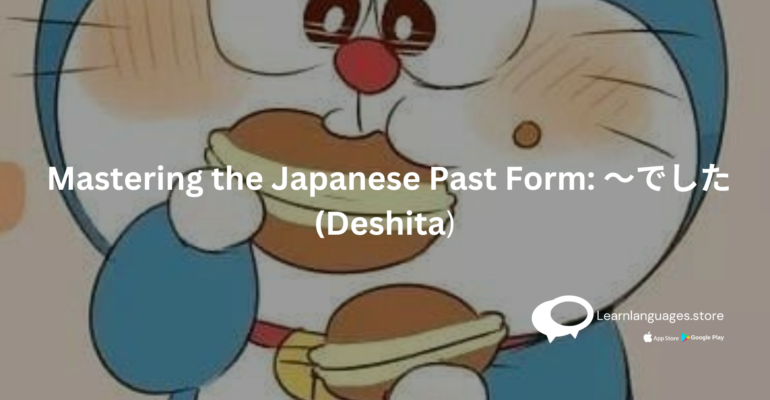Title: Mastering the Japanese Past Form: 〜でした (Deshita)
Title: Mastering the Japanese Past Form: 〜でした (Deshita)
Estimated reading time: 3 minutes

Introduction
When learning Japanese, one of the essential elements is understanding verb conjugations, especially the past tense. Today, we’ll dive into the world of the past form: 〜でした (deshita). This polite form is used frequently in everyday conversations and formal settings. By the end of this post, you’ll be a 〜でした master, equipped with many examples, a bit of humor, and a lot of knowledge!
Explanation of 〜でした (Deshita)
The past form 〜でした is the polite past tense form of です (desu), which means “is/am/are.” It is used to state something that was true in the past.
Sentence Structure:
𝑆𝑢𝑏𝑗𝑒𝑐𝑡Subject + 𝑁𝑜𝑢𝑛/𝐴𝑑𝑗𝑒𝑐𝑡𝑖𝑣𝑒Noun/Adjective + でした (deshita)
Examples with Humor
- Simple Statement
- Japanese: 彼は先生でした。
- Pronunciation: kare wa sensei deshita.
- Hindi Translation: वह एक शिक्षक था।
- English Translation: He was a teacher.
- Japanese: 彼は先生でした。
- Funny Example
- Japanese: 彼の夢はスーパーヒーローでした。
- Pronunciation: kare no yume wa suupaa hiroo deshita.
- Hindi Translation: उसका सपना सुपरहीरो बनना था।
- English Translation: His dream was to be a superhero.
- Japanese: 彼の夢はスーパーヒーローでした。
- Reflective Statement
- Japanese: 私の犬はとてもかわいかったでした。
- Pronunciation: watashi no inu wa totemo kawai katta deshita.
- Hindi Translation: मेरा कुत्ता बहुत प्यारा था।
- English Translation: My dog was very cute.
- Japanese: 私の犬はとてもかわいかったでした。
Sentence Structure and Usage
In Japanese, the past form 〜でした is straightforward to use. Simply replace です (desu) with でした (deshita) to change a present tense sentence into past tense.
Exceptions and Special Cases
- Adjectives Ending in -い: When dealing with い-adjectives, でした is not used. Instead, you conjugate the adjective itself.
- Example: 楽しい (tanoshii) IS い-adjective, becomes 楽しかった (tanoshikatta).
- Negative Form: The negative past form for です (desu) is ではありませんでした (dewa arimasen deshita).
- Example: 彼は学生ではありませんでした。
- Pronunciation: kare wa gakusei dewa arimasen deshita.
- Hindi Translation: वह एक छात्र नहीं था।
- English Translation: He was not a student.
- Example: 彼は学生ではありませんでした。
Identifying in a Sentence
In a sentence, 〜でした (deshita) is used to indicate that the state of being described was in the past. This is crucial in storytelling and providing historical context.
Conclusion
Mastering the past form 〜でした is a vital step in becoming proficient in Japanese. It allows you to communicate about the past in a polite and respectful manner. Remember, practice makes perfect, so use these examples and explanations to solidify your understanding.
-
Product on sale
 Japanese N4
Japanese N4₹18,300.00
₹24,300.00 -
Product on sale
 Japanese N5
Japanese N5₹16,300.00
₹18,300.00
Learn Languages Store
Vashi,
Email: services@learnlanguages.store










